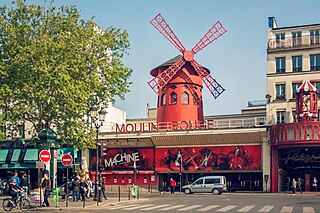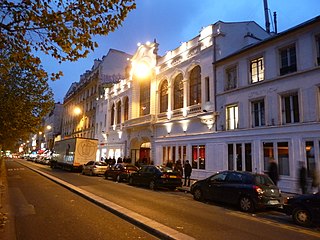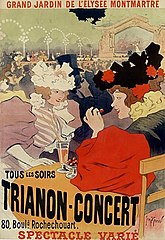
Moulin Rouge is a cabaret in Paris, on Boulevard de Clichy, at Place Blanche, the intersection of, and terminus of Rue Blanche.

Cabaret is a form of theatrical entertainment featuring music, song, dance, recitation, or drama. The performance venue might be a pub, a casino, a hotel, a restaurant, or a nightclub with a stage for performances. The audience, often dining or drinking, does not typically dance but usually sits at tables. Performances are usually introduced by a master of ceremonies or MC. The entertainment, as performed by an ensemble of actors and according to its European origins, is often oriented towards adult audiences and of a clearly underground nature. In the United States, striptease, burlesque, drag shows, or a solo vocalist with a pianist, as well as the venues which offer this entertainment, are often advertised as cabarets.

Montmartre is a large hill in Paris's northern 18th arrondissement. It is 130 m (430 ft) high and gives its name to the surrounding district, part of the Right Bank. Montmartre is primarily known for its artistic history, for the white-domed Basilica of the Sacré-Cœur on its summit, and as a nightclub district.

The Olympia is a concert venue in the 9th arrondissement of Paris, France, located at 28 Boulevard des Capucines, equally distancing Madeleine church and Opéra Garnier, 300 metres (980 ft) north of Vendôme square. Its closest métro/RER stations are Madeleine, Opéra, Havre – Caumartin, and Auber.

Ange-Jacques Gabriel was the principal architect of King Louis XV of France. His major works included the Place de la Concorde, the École Militaire, and the Petit Trianon and opera theater at the Palace of Versailles. His style was a careful balance between French Baroque architecture and French neoclassicism.

Anggun Cipta Sasmi is an Indonesian and French singer, songwriter, and television personality. Born in Jakarta, she began performing at the age of seven and recorded a children's album two years later. She rose to fame in 1989 as a teenage rock star and by 1993 she had released five Indonesian-language studio albums. Rolling Stone listed her single "Mimpi" as one of the 150 Greatest Indonesian Songs of All Time.

The Hammerstein Ballroom is a 12,000-square-foot (1,100 m2) ballroom located within the Manhattan Center at 311 West 34th Street in Midtown Manhattan, New York City. The capacity of the ballroom is dependent on the configuration of the room; it seats 2,500 people for theatrical productions and musical performances, and several thousand for events held within a central ring. The floor of the ballroom is flat. The two main balconies – which are unusually close to the ground and gently sloped – seat a total of 1,200. The third balcony has been stripped of seats and is not used.

DeVos Place Convention Center, erected on the Grand River in downtown Grand Rapids, Michigan, is a multi-purpose convention center. It is named for Richard DeVos, who donated $20 million towards its construction.

Le Chat Noir was a nineteenth-century entertainment establishment, in the bohemian Montmartre district of Paris. It was opened on 18 November 1881 at 84 Boulevard de Rochechouart by the impresario Rodolphe Salis, and closed in 1897 not long after Salis' death.

Maxime-Pierre Jules Dethomas was a French painter, draughtsman, printmaker, illustrator, and was among the best known theater-set and costume designers of his era. As an artist, Dethomas was highly regarded by his contemporaries and exhibited widely, both within France and abroad. He was a regular contributor to the Impressionistes et Symbolistes, and a founding committee member of the Salon d'Automne. In 1912, he was awarded the Chevalier de la Légion d'honneur for his contributions to French art.

Élysée Montmartre is a music venue located at 72 Boulevard de Rochechouart, Paris, France. It opened in 1807, burned down in 2011, reopened in 2016, and has a capacity of 1,380 patrons. The nearest métro station is Anvers.

Le Grand Rex is a cinema and concert venue in Paris, France.

The Boulevard Marguerite-de-Rochechouart is a street in Paris, France, situated at the foot of Montmartre and to its south. Like the neighbouring street, it is named after Marguerite de Rochechouart de Montpipeau (1665–1727), abbess of Montmartre. It is a result of the 1864 merging of the boulevards and chemins de ronde which followed the interior and exterior of the Wall of the Farmers-General. It has also been known as the boulevard des Poissonniers, chemin de ronde de Poissonnière and chemin de ronde de Rochechouart. It is served by the Paris Metro stations Pigalle, Anvers and Barbès – Rochechouart.

The Théâtre Marigny is a theatre in Paris, situated near the junction of the Champs-Élysées and the Avenue Marigny in the 8th arrondissement.

Édouard-Jean Niermans was a famous Dutch-born French architect during the Belle Époque.
Henri Révoil (1822–1900) was a 19th-century French architect.

CAPC musée d'art contemporain de Bordeaux, formerly the Centre d'arts plastiques contemporains (CAPC), is a museum of modern art established in 1973 in Bordeaux, France.

Julien Labrousse, is a French entrepreneur and architect, particular owner and manager of two Parisian theaters Elysée Montmartre and Le Trianon. He specializes in the creation of cultural venues. In 2005 he bought and heavily reformed Hôtel du Nord, building listed as an historical monument, a place which is known to have inspired Marcel Carné's 1938 feature film. Then in 2009 he bought with Abel Nahmias, the Theatre Le Trianon. It carries a heavy restoration of the building. Then it was the turn of the Elysee Montmartre, which he bought in 2014, destroyed after a major fire. He realizes the complete reconstruction of the Theater.



























